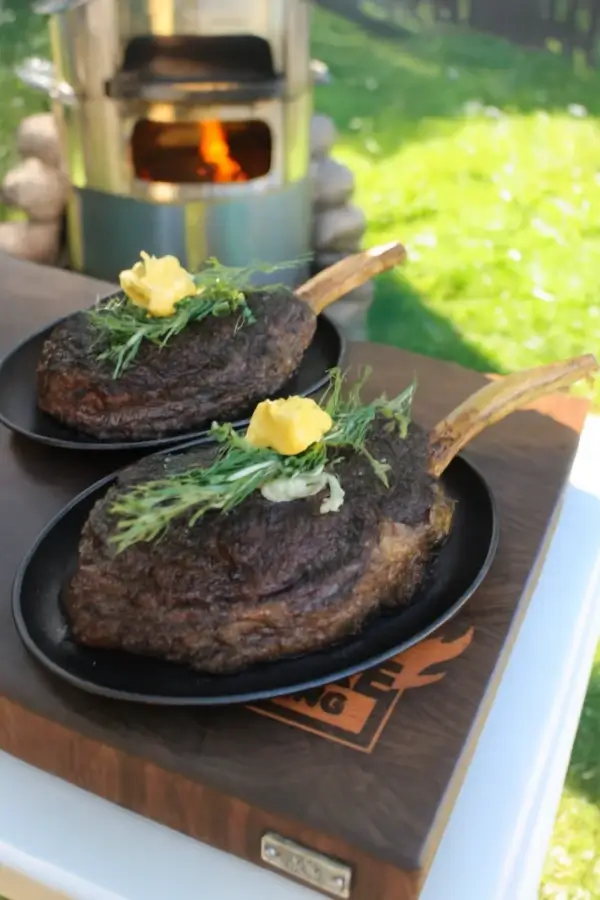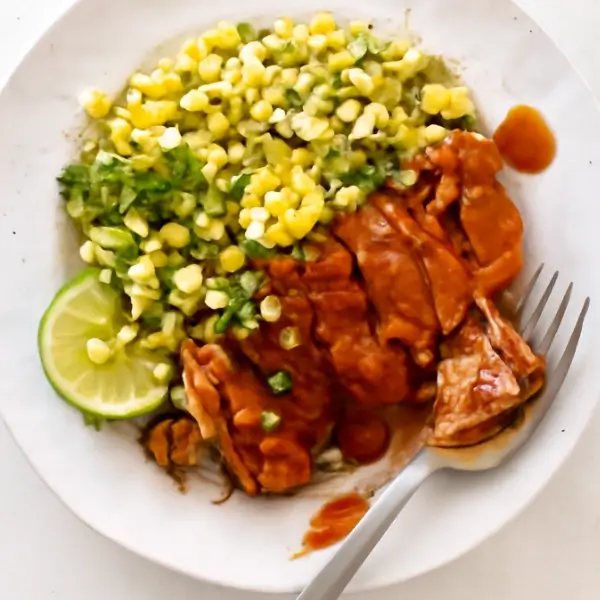The first time I tried Bibim Mandu (Korean Potsticker Salad), it was at a tiny late-night food stall tucked behind a busy Seoul alley. I wasn’t expecting much—just a quick bite. But that first forkful? Crispy, golden dumplings still warm from the pan tangled up with cool shredded veggies and a bold, spicy-sweet dressing that hit every taste bud. It was love at first crunch.
If you’re craving something that feels fresh but still indulgent, Bibim Mandu is it. This dish balances crispy dumplings with chilled salad in a way that’s hard to forget. Whether you’re new to Korean food or just looking for something different, this Korean potsticker salad delivers comfort, punchy flavors, and just enough wow to impress anyone at the table.
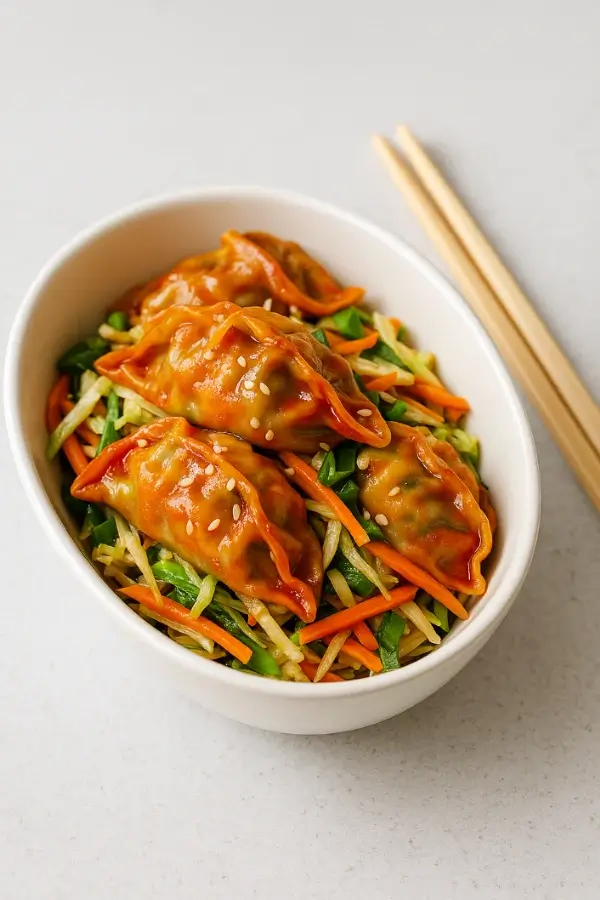
Table of Contents
Why You’ll Love This Recipe
– Quick & Easy: From freezer to table in about 20 minutes. Perfect for weeknights or last-minute guests.
– Simple Ingredients: Uses pantry staples plus frozen dumplings—nothing fancy, just real flavor.
– Bold, Balanced Flavors: The sauce hits all the right notes—spicy, sweet, tangy, and rich.
– Texture Heaven: Crunchy lettuce, crisp dumplings, and smooth dressing create an unbeatable combo.
– Crowd-Pleaser: It’s fun to serve and even more fun to eat. Great for dinner parties, casual lunches, or Korean-themed nights.
– Customizable: You can swap veggies, adjust the spice, or use your favorite dumplings.
Unlike other versions, this one focuses on keeping the dumplings crisp and the salad light—so each bite feels fresh, flavorful, and satisfying.
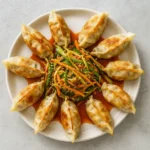
Bibim Mandu: Crispy Korean Potsticker Salad
- Total Time: 15
- Yield: 4 1x
Description
Unlock the secrets to amazing Bibim Mandu. This comprehensive guide reveals how to achieve perfectly crispy Korean potstickers and a balanced, sweet-spicy salad. Cook like a pro today!
Ingredients
- 14 pieces frozen dumplings (180–500 g / 6–17 oz)
- 4 lettuce leaves (40 g), thinly sliced
- 35 g cabbage, thinly sliced
- 1/2 Lebanese cucumber (65 g), julienned
- 1/4 carrot (25 g), peeled, julienned
- Some cooking oil (e.g., rice-bran oil)
- 1/4 cup water
- 1.5 Tbsp Korean chili paste (gochujang)
- 1 Tbsp rice vinegar
- 1 Tbsp soy sauce
- 1 Tbsp honey
- 1 Tbsp raw sugar
- 1 Tbsp sesame oil
- 1 Tbsp toasted sesame seeds
Instructions
- Wash and prepare all vegetables as directed.
- In a small bowl, whisk gochujang, rice vinegar, soy sauce, honey, raw sugar, sesame oil, and toasted sesame seeds to form the dressing.
- Heat a skillet over medium heat with a little oil. Arrange frozen dumplings flat-side down; cook 1 minute until bottoms start to brown.
- Add 1/4 cup water, cover, reduce heat, and steam until water evaporates. Uncover, drizzle a touch more oil, and cook until dumplings are crisp and golden, about 4 minutes more. Let cool slightly.
- In a large bowl, combine lettuce, cabbage, cucumber, carrot, and warm dumplings. Drizzle with dressing and toss just before serving.
- For extra-crisp presentation, dress only the vegetables, mound them center-plate, and ring the dumplings around the edge.
Notes
Cook dumplings straight from frozen—no thawing needed.
Adjust the amount of gochujang to suit your heat preference.
Air-fry the dumplings instead of pan-frying for an even lighter crunch.
- Prep Time: 5
- Cook Time: 10
- Category: Appetizer
- Method: Stovetop
- Cuisine: Korean
Nutrition
- Serving Size: 1 serving
- Calories: 137
- Sugar: 12
- Sodium: 377
- Fat: 6
- Saturated Fat: 1
- Unsaturated Fat: 5
- Trans Fat: 0
- Carbohydrates: 18
- Fiber: 1
- Protein: 2
- Cholesterol: 0
Ingredients Needed
You’ll need just a few simple ingredients to bring this bold and crunchy Bibim Mandu (Korean Potsticker Salad) to life. Here’s what to prepare:
For the Base
– 14 frozen dumplings (180–500g / 6 to 17 oz) – vegetable, tofu, chicken, or kimchi (without shrimp) varieties work well
– 4 lettuce leaves (about 40g / 1.4 oz), finely shredded
– A handful of cabbage (about 35g / 1.2 oz), thinly sliced
– 1/2 small cucumber (~65g / 2.3 oz), julienned
– 1/4 carrot (about 25g / 0.9 oz), peeled and cut into thin strips
– Neutral cooking oil – like rice bran, canola, or sunflower
– 1/4 cup water – for steaming during pan-frying
For the Sweet, Spicy & Tangy Dressing
– 1.5 tablespoons Korean chili paste (gochujang) – choose a version without anchovy or added alcohol
– 1 tablespoon rice vinegar – check label for clean ingredients
– 1 tablespoon soy sauce – use a naturally brewed, additive-free brand
– 1 tablespoon honey – smooth and natural sweetness
– 1 tablespoon raw sugar – adds depth and balances the spice
– 1 tablespoon sesame oil – for nutty richness
– 1 tablespoon toasted sesame seeds – for crunch and aroma
Everything should be easy to find at most grocery stores with an international section. Let’s move on to how to make it all come together.
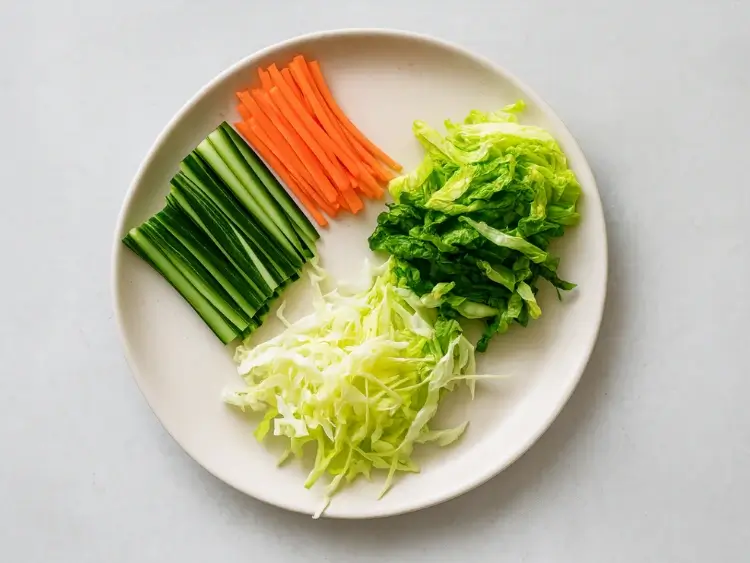
How to Make Bibim Mandu (Korean Potsticker Salad)
Making Bibim Mandu (Korean Potsticker Salad) at home is easier than it looks. With the right timing, you’ll have crispy dumplings, cool veggies, and a bold sauce ready to impress.
1. Prep the Vegetables
Start by washing all your vegetables thoroughly. Thinly shred the lettuce and cabbage. Julienne the cucumber and carrot into matchsticks. Once prepped, set them aside in a large bowl or on a clean tray—this helps you stay organized as you build your Korean potsticker salad.
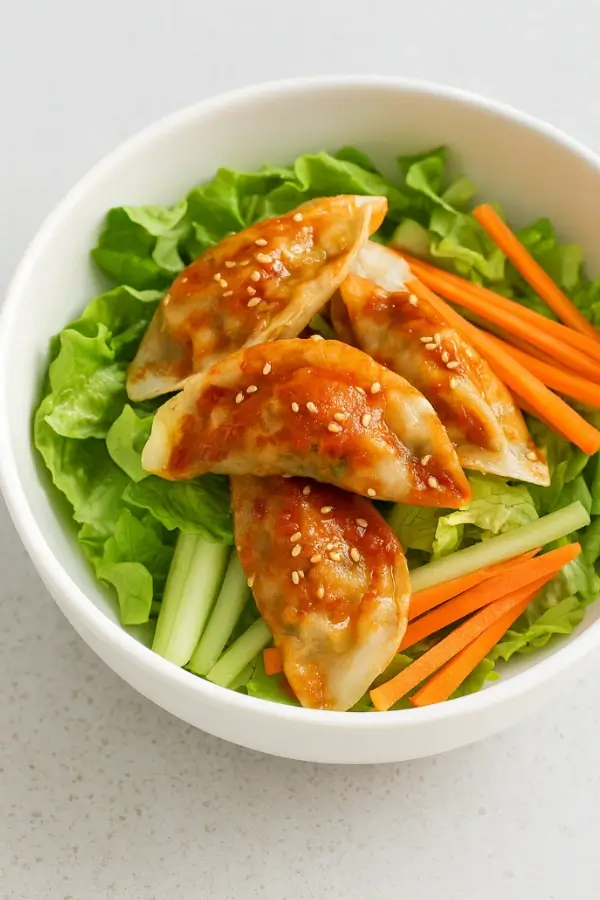
2. Mix the Dressing
In a small bowl, stir together gochujang, rice vinegar, soy sauce, honey, raw sugar, sesame oil, and toasted sesame seeds. Mix until smooth and glossy.
📝 Tip: Taste and adjust. Want it spicier? Add a bit more chili paste. Sweeter? A touch more honey.
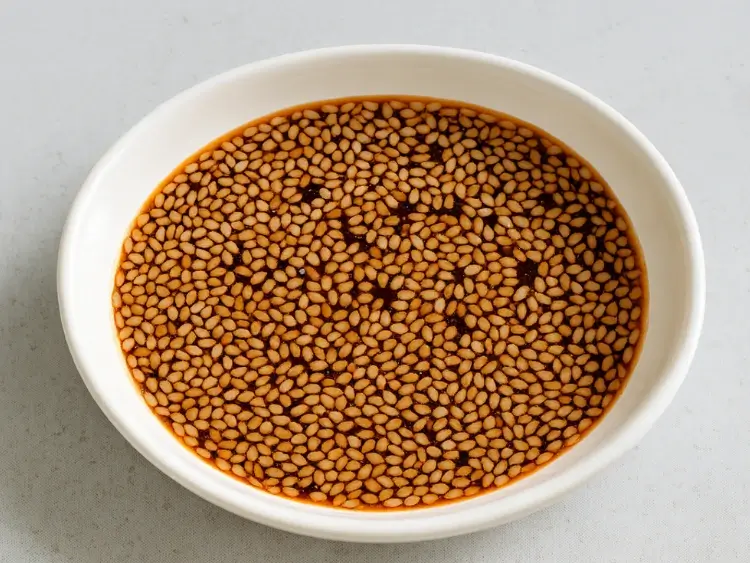
3. Pan-Fry the Dumplings
Place a nonstick pan over medium heat. Add oil and spread evenly. Arrange the frozen dumplings in one layer. Let the bottoms brown for about 1 minute.
Add 1/4 cup of water, cover with a lid, and lower the heat slightly. Let them steam for 3–4 minutes. Once the water evaporates, uncover the pan, drizzle in a little more oil, and raise the heat again. Turn the dumplings occasionally until all sides are golden and crisp.
Let them cool slightly before adding to the Bibim Mandu—this keeps them from softening too much in the salad.
4. Combine and Toss
In a large bowl, toss your vegetables with the dressing until well coated. Add the crispy dumplings just before serving and toss gently to keep their crunch. This step brings everything together into the signature mix that defines Bibim Mandu (Korean Potsticker Salad).

5. Serve it Right
You can plate the salad in a large shallow bowl with the dumplings nestled around the edge, or mix everything and scoop it right onto a platter. Either way, the textures and flavors make this Bibim Mandu recipe a standout for any occasion.
Serving and Storage Tips
How to Serve Bibim Mandu (Korean Potsticker Salad)
– Serve right after tossing. The contrast between warm dumplings and cold, crisp vegetables is what makes this dish special.
– Use a wide plate or shallow bowl. It helps distribute the dressing evenly and keeps everything crisp.
– Garnish for extra appeal. A sprinkle of sesame seeds or a few sliced scallions on top adds visual and flavor flair.
– Pair it with light sides. It goes well with a bowl of steamed rice, a simple broth, or lightly pickled vegetables.
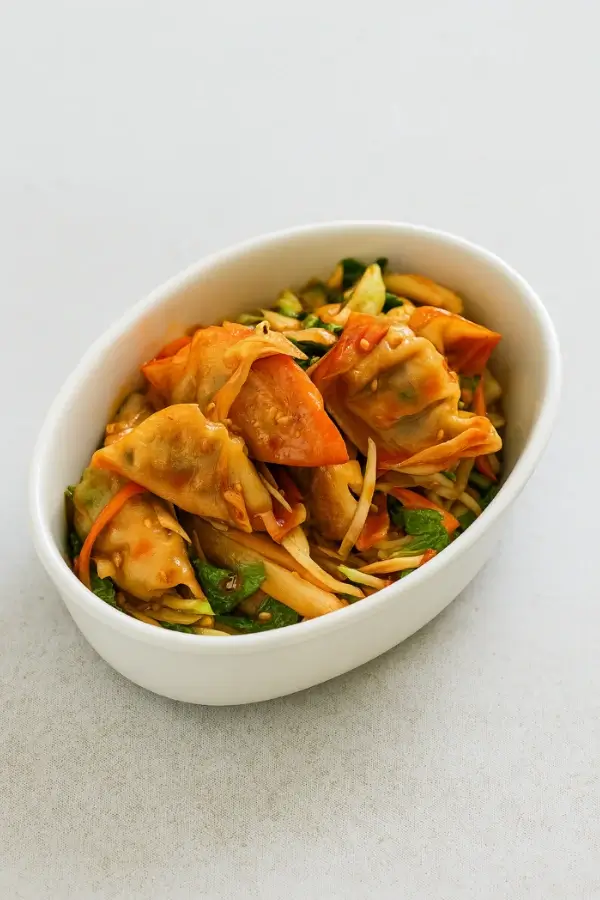
How to Store Leftovers
– Store components separately. Keep the dumplings and salad in different containers to maintain texture.
– Reheat dumplings in a pan. Skip the microwave to keep them crisp—use a skillet on medium heat for best results.
– Eat within 24 hours. After a day, the vegetables may lose their crunch and the dressing can soften the dumplings.
Helpful Notes
– Mix Bibim Mandu (Korean Potsticker Salad) just before serving: This helps the dumplings stay crisp and the salad stay fresh.
– Use a non-stick pan: It’s the best way to get that golden crust on your dumplings without tearing them.
– Adjust the spice level: Add extra chili flakes for more heat, or reduce gochujang for a gentler bite.
– Dumpling choices matter: Whether you go with tofu, vegetable, or mild chicken, they all bring something unique to your Bibim Mandu.
– Top with crunch: Try crushed peanuts, radish slices, or crispy shallots for added texture.
– Make-ahead tip: Slice your veggies and mix the sauce earlier in the day. Keep them chilled, then assemble when you’re ready.
– Serving idea: For a clean presentation, plate your salad in the center and arrange the dumplings around the edge. It gives your Korean potsticker salad that restaurant-style look.
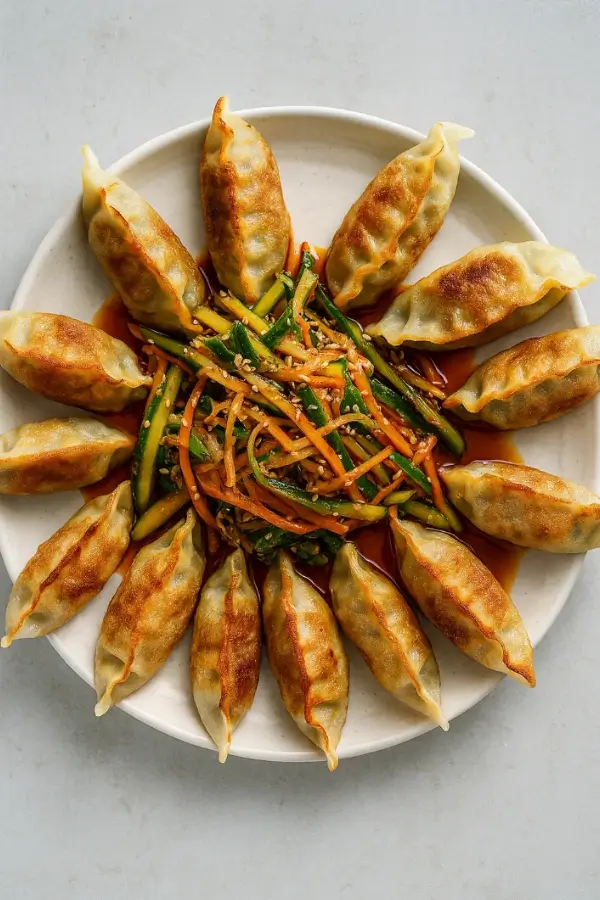
Frequently Asked Questions
Is Bibim Mandu served hot or cold?
It’s served warm and cold at the same time. The dumplings are pan-fried until golden, then slightly cooled before mixing with the chilled salad and sauce. The contrast in temperature is part of the appeal.
What kind of dumplings should I use for Bibim Mandu?
Frozen dumplings work great. Choose from vegetable, tofu, chicken, or kimchi options based on your taste. Just avoid anything too soft—they should hold up to frying and tossing.
Can I make the Bibim Mandu dressing ahead of time?
Yes. Mix the sauce in advance and store it in the fridge in a sealed container. Give it a stir before using—it keeps well for 3–4 days.
How do I get my dumplings extra crispy?
Brown the bottoms first for about a minute, then steam with a bit of water. Once the water evaporates, uncover the pan, add a bit more oil, and crisp all sides on medium heat. Don’t rush—it’s worth it.
Can I prepare the vegetables in advance?
Absolutely. Slice and chill them ahead of time, but wait to toss everything with the sauce until just before serving to keep the salad and dumplings crisp.
What if I don't have all the Korean ingredients?
For gochujang, look for alternatives like a spicy chili paste or a mix of chili sauce and a touch of miso. For rice vinegar or soy sauce, standard pantry versions usually work fine—just check the label for added flavors or ingredients.
Is Bibim Mandu a main dish or an appetizer?
Both! It works great as a light main meal or a party-friendly appetizer. It’s quick, colorful, and easy to scale up or down depending on the crowd.
Conclusion
If you’re craving something bold, fresh, and satisfying, Bibim Mandu (Korean Potsticker Salad) checks every box. It brings together crispy dumplings, crunchy vegetables, and a punchy sauce that’s hard to forget. Whether you’re serving it as a quick lunch, party appetizer, or just treating yourself, this dish delivers big flavor with simple steps.
Tried this Bibim Mandu recipe? Leave a comment below and rate it with stars—your feedback means a lot. And if you made your own twist, we’d love to hear about it!
Don’t forget to share your plate on social media—tag your photos on Pinterest or Facebook so others can see your take on this Korean favorite.
Love Easy, Flavor-Packed Recipes
If you’re enjoying this recipe and want more quick, delicious meals like it, follow us on Facebook and Pinterest for new posts, cooking tips, and behind-the-scenes peeks from my Brooklyn kitchen. We share weekly ideas to make your time in the kitchen easier—and more fun.

